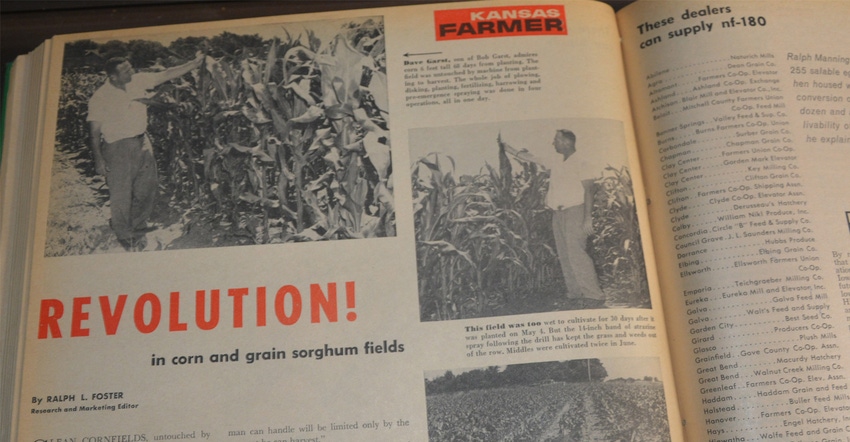June 29, 2020

Herbicides were offering a “revolution” in corn and grain sorghum fields back in 1960.
Kansas Farmer editors were invited to tour fields that had been “chemically weeded” in Coon Rapids, Iowa fields. A 4-acre field that had been plowed, disked, planted, fertilized and sprayed on May 1 had corn that was 6 feet tall with no sign of grasses or weeds at the time of the walk-thru on July 7.
The “miracle” chemical was Atrazine 80W.
65 years ago
A new vaccine was made available to poultry farmers in August of 1955, enabling them to vaccinate their chickens against Newcastle disease by adding the vaccine to the drinking water in the chicken house.
The water vaccine was mixed in a 12- to 24-hour water supply when chicks were 4 days old and again when they were 4 weeks old. A final dose was given at 4 months of age, provided the poultry had not been sold as broilers or fryers by that time.
50 years ago
Soilborne wheat mosaic virus and wheat streak mosaic virus combined to cost Kansas wheat farmers $2 million in damage to the 1970 wheat crop.
Soilborne wheat mosaic virus can live in the soil indefinitely, regardless of crop rotation.
Wheat streak mosaic virus, a totally different virus, is vectored by the wheat curl mite, which survive primarily in volunteer wheat that comes up in the stubble of harvested fields.
30 years ago
The year was 1990, and the quest for hybrid wheat success had narrowed to only one survivor, Hybritech Seed International, located north of Wichita.
The history of Hybritech traced back to 1961 and the Dekalb hybrid wheat program. It is now 30 years later and the quest for hybrid wheat success is still on.
20 years ago
The watchword of the day was white wheat, which was being promoted as a specialty crop targeting bottom line improvement for Kansas wheat growers.
Daryl Strouts, then executive director of the Kansas Crop Improvement Association, said the goal was to enable farmers to deliver a wheat that millers and bakers, and ultimately consumers, wanted to receive. He added that any producer who could grow high-quality hard red winter wheat would be able to grow high-quality white wheat.
At the same time, wheat leaders were warning about something that time would prove to be true: For many farmers, the struggle to keep white and red wheat separate and identity-preserved would be a challenge many could not overcome.
Goerzen is executive director of the Old Cowtown Museum in Wichita.
About the Author(s)
You May Also Like




